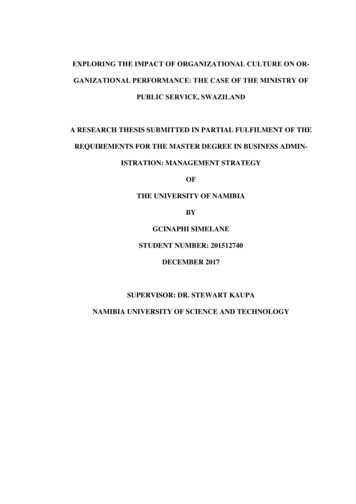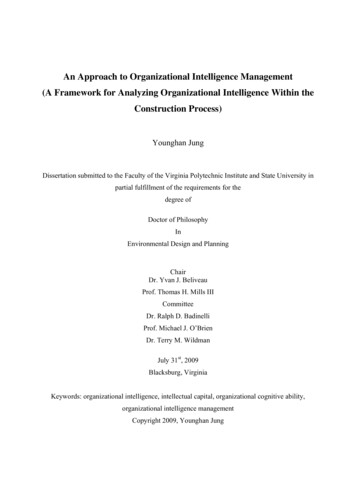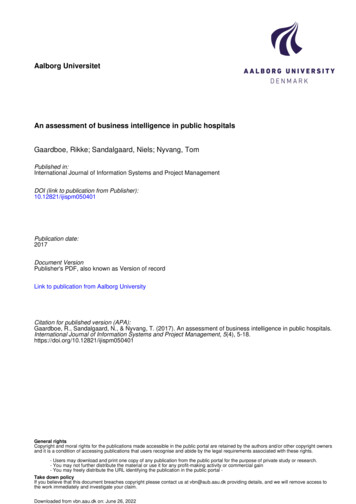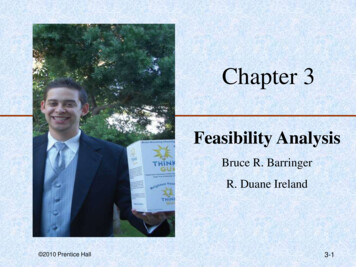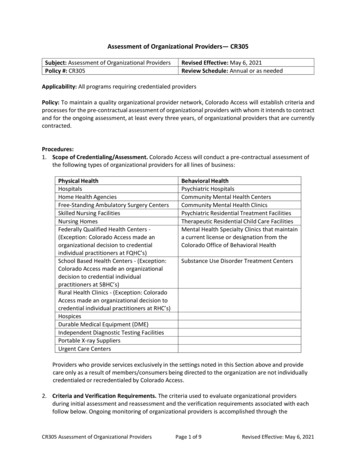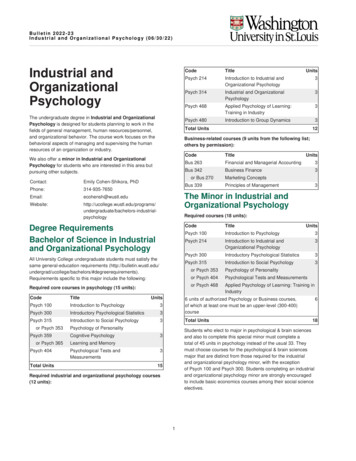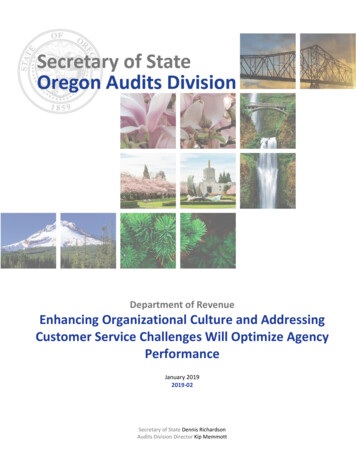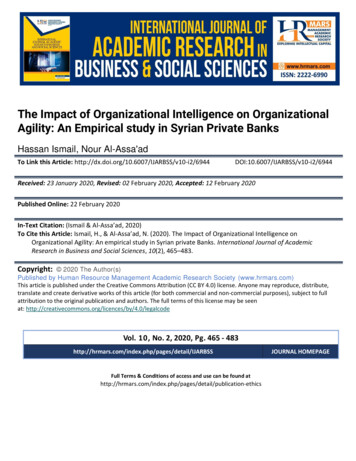
Transcription
International Journal of Academic Research in Business and Social SciencesVol. 1 0 , No. 2, Feb, 2020, E-ISSN: 22 2 2 -6990 2020 HRMARSThe Impact of Organizational Intelligence on OrganizationalAgility: An Empirical study in Syrian Private BanksHassan Ismail, Nour Al-Assa'adTo Link this Article: 0.6007/IJARBSS/v10-i2/6944Received: 23 January 2020, Revised: 02 February 2020, Accepted: 12 February 2020Published Online: 22 February 2020In-Text Citation: (Ismail & Al-Assa’ad, 2020)To Cite this Article: Ismail, H., & Al-Assa’ad, N. (2020). The Impact of Organizational Intelligence onOrganizational Agility: An empirical study in Syrian private Banks. International Journal of AcademicResearch in Business and Social Sciences, 10(2), 465–483.Copyright: 2020 The Author(s)Published by Human Resource Management Academic Research Society (www.hrmars.com)This article is published under the Creative Commons Attribution (CC BY 4.0) license. Anyone may reproduce, distribute,translate and create derivative works of this article (for both commercial and non-commercial purposes), subject to fullattribution to the original publication and authors. The full terms of this license may be seenat: deVol. 10, No. 2, 2020, Pg. 465 - SFull Terms & Conditions of access and use can be found tion-ethicsJOURNAL HOMEPAGE
International Journal of Academic Research in Business and Social SciencesVol. 1 0 , No. 2, Feb, 2020, E-ISSN: 22 2 2 -6990 2020 HRMARSThe Impact of Organizational Intelligence onOrganizational Agility: An empirical Study in SYRIANPrivate BanksHassan Ismail, Nour Al-Assa'adResearcher, Department of Human Resources management, Higher Institute of BusinessAdministration (HIBA), Damascus, SyriaEmail: Hassanisml@gmail.com, Nour.damaso993@gmail.comAbstractThis research aims to test the effect of organizational intelligence on organizational agility, which was appliedon workers at top and middle management levels in Syrian private banks from Damascus city, A total sampleof 160 employees was selected.In order to achieve the objective of the research, a descriptive analytical approach was adopted. Secondarydata were collected from previous studies and related references, while the questionnaire was the mainresearch tool for collecting primary data.To identify the dimensions of organizational intelligence, the study utilized the scale of (Albrecht, 2002), andin order to measure organizational agility, the researcher used the scale of (park, 2011).After testing the research hypothesis, the main results of the research are:There is a significant effect of one dimension of organizational intelligence (strategic vision) onSensing Agility, There is a significant effect of organizational intelligence dimensions (Appetite forChange - strategic vision - Alignment and Congruence) on Decision-making Agility, There is asignificant effect of organizational intelligence dimensions (Appetite for Change - strategic vision alignment and Congruence) on Decision-making Agility.Keywords: Organizational Intelligence, Organizational Agility, Strategic Vision, Shared Fate, Appetitefor Change, Heart, Alignment and Congruence, Knowledge development & performance pressure,Sensing Agility, Decision-making Agility, Acting Agility/PracticingIntroductionIn the present era, institutes, organizations, departments with any missions, aim or prospect act at anational or international level and they have to respond to the needs of the customers and thosewho benefit from their service. Therefore, studying the results of their functioning will be consideredan important strategic process. The recent study in the area of human resources indicated that thefive attributes of personality, predisposition, interest, intelligence, and skill are very effective andimportant for the improvement of organizational goal, job satisfaction, organizational learning, the
International Journal of Academic Research in Business and Social SciencesVol. 1 0 , No. 2, Feb, 2020, E-ISSN: 22 2 2 -6990 2020 HRMARStendency for knowledge and the creativity coefficient and assessment of the staff. And, theseattributes are very important for the success of the human resources. Today we can claim with onehundred percent of confidence that the identification and the use of organizational intelligence canimprove the compatibility of an organization and can make it distinct from other organizations.The necessity to study organizational intelligence at the present time is actually response to thepresent needs of the managers (Daraei, Ahmadi and Faraji, 2015). In addition, the increasing speedof the changes in the modern technology in one hand, and the changes of the identity of customer’sdemands and also the increasing competition between organizations on the other hand caused theorganizations to follow new competitive advantages in order to be superior to their rival and answerthe needs of their customers better. Regarding this problem, it seems that moving towards creatingan organization which is highly flexible in response to the changing, unstable and unpredictablecondition and environment, is a new and vital solution. Achieving this goal is only possible under theumbrella of a new concept called organizational agility.Therefore, the value and importance of organizational agility is that it equals the speed and quicknessof responsiveness and organizational flexibility against changes (Adel & Pishdar, 2011)Today, the agility is considered as dominant paradigm in the third millennium and as the best optionfor survival of organizations which is considered by the general manufacturing and serviceorganizations.Today, the agility is considered as dominant paradigm in the third millennium and as the best optionfor survival of organizations which is considered by the general manufacturing and serviceorganizations.Following this consideration, some efforts have run to achieve the desired level of organizationalagility. Agility only is achieved by hierarchical integration of customers in the context of theorganization's internal and external environment. This is done by having a comprehensive viewtowards advanced technology in manufacturing organizations with their internal capabilities and alsousing the information technology (Ramesh and Devadasan, 2009).In fact, organizational agility can easily cause significant change in the focus, diversification andrenovation of business for accelerating the achievement of a specific goal; in a way that can createvaluable opportunities for the organization. These organizations can precede in the competition andthe key to this issue is strategic planning which represents a wide map of abilities, capabilities andmain skills of the organization; Therefore, each section determines the policies for increasing theorganizational agility based on its specific strategies.Agile organization combines the processes and people with the advanced technology and the needsof the customers to present services with high quality is quite short time. Agility constantly paysattention to the performance of the personnel and the organization, value of the products andservices and opportunities for attracting customers and requires permanent preparedness toconfront the fundamental and surface changes and agile organizations are always ready to learn newthings in order to increase profitability resulting from new opportunities.Agility creates an essential ability in order for the organization to sense, receive, observe, analyze andpredict the changes in the environment. Therefore, an organization is agile if it has a wide view aboutthe new global order and confronts the turmoils with its abilities and competencies and seize theadvantage aspects of trends.The purpose of the current research is to: 1) study the Impact of Organizational Intelligence onOrganizational Agility, 2) provide solutions for improving organizational agility based on
International Journal of Academic Research in Business and Social SciencesVol. 1 0 , No. 2, Feb, 2020, E-ISSN: 22 2 2 -6990 2020 HRMARSorganizational intelligence.Literature Review and Hypothesis DevelopmentThe initial idea of organizational intelligence (OI) has been addressed by most of the researchers overthe past few decades in various research disciplines (Albrecht, 2003; Travica, 2014; Wassermann,2001; (Cronin & Davenport, 1991); Argyris & Schön, 1978; Wilensky, 1967).Few researchers argued that an intelligent organization have the capacity to take right decisions(March, 1999; Quinn 1992; Wilensky, 1967) while others feels that it is up to the organization thathow to fit in environment for its survival and growth (Thannhuber, 2005; Gupta & Sharma, 2004).The early concept of OI came into academic setting in 1980s. However, later on, some authors believethat it was the Michel Porter who first introduced the concepts of organizational intelligence andcompetitive intelligence. On the other hand, it is firmly believed that (Karl Albrecht, 2003) has beenconsidered as the pioneers in introducing the concept and real model of OI. He has argued thathuman resources are one of the very intelligent and competent in performing all the organizationaltasks but on the other hand he has highlighted the competitive abilities of a collective mental powerin doing great jobs (Bakhshian, Hamidi, & Ezati, ,2011).Organizational intelligence: having a deep knowledge about all factors like customers (the societyand addresses, clients, etc), competitors, economic environment, operation and organizationalprocesses (financial, sale, production, human resources, etc) which have a great effect onmanagement decision makings in the organization is organizational intelligence. Organizationalintelligence enables you for decision making in all factors effective on the organization and companies(Chaman, Hesam & Yazdanpanah, 2016) Organizational intelligence includes an organization talentand capacity for rousing the organization mental ability and concentrating this ability for reaching theorganizational prophecy.Experts have provided different definitions of organizational intelligence:1. Glynn argues that organizational intelligence is the result of addition and interaction of theintelligences of the individuals in an organization. Organizational intelligence is a social process whosetheory is designed based on human intelligence theories (Glynn, 1996).2. McMaster (1996) defined organizational intelligence as the capacity of a system to accumulateinformation, innovation, production of knowledge and deploying that knowledge in the organization(McMaster,1996).3. According to Liebowitz, organizational intelligence can be defined as a horde of all intelligenceswhich are employed in order to create a common outlook, to conduct revision process and to directthe whole system (Liebowitz, 1999).4. In Simic’s opinion, organizational intelligence is intellectual ability of an organization to solveorganizational problems and its emphasis is on the concentration of human and technical abilities inproblem-solving (Simic, 2005).5. Matsuda contends that organizational intelligence is a complex, interactive, accumulated, coordinating set of the organization’s human and machine intelligences as a whole (Matsuda, 1988).6. Karl Albrecht defines organizational intelligence as the ability that provokes intellectualpacities of an organization and concentrates them to reach the missions (Albrecht, 2003).ca-
International Journal of Academic Research in Business and Social SciencesVol. 1 0 , No. 2, Feb, 2020, E-ISSN: 22 2 2 -6990 2020 HRMARS7. In Halal’s idea, organizational intelligence is creating and deploying the proper knowledge in adaptation to the environment (Halal, 2000).8.(Kord, Ghasemi & Amin, 2013) considers organizational intelligence the ability of an organization incomprehending and responding to the environment in order to achieve its goals and satisfies itsstakeholders (Kord, Ghasemi and Amin, 2013).9. Leon and Gabriela maintain that organizational intelligence is the ability of an organization increating knowledge and deploying it strategically so as to adapt to its environment (Leon, Florin,Gabriela & Atanasiu, 2009).Components of Organizational IntelligenceAccording to (Albrecht, 2003), he coined the concept of organizational intelligence into sevendimensions. Each of the seven dimensions of organizational intelligence contains a set of behaviors,structural characteristics, processes or specific way they function. Each of these characteristics hastheir own causes or history.Records may include organizational structures, competitive leadership, products and processes tosuit the needs of the business environment, interrelated missions, clear goals, core values andpolicies which define the rights and functions of the staff as well. In each of these dimensions can beidentified multiple records to increase the elements of organizational intelligence in their maximumlevel. The seven dimensions are including as below (Sattari, 2007). Strategic Vision: Every organization in a sense needs an organized principle and a definitionof the destination it is attempting to reach. The leaders of organizations have to have answersto these questions: Who are we? What do we exist for? What is the philosophy of ourexistence? Why should our fellow countrymen and even the people of the world accept us,appreciate us and pay us for what we do? Notice that strategic vision refers to organizationalability in creating, nourishing, and expressing the aims of the organization. The assumption ofthe strategic vision is that the leaders are able to express the concept of success and whenneeded they are able to recreate this concept (Albrecht, 2003). Shared Fate: This means that the staffs are able to cooperatively step towards their visionsand reach a feeling of “being on the same boat.” This gives them a sense of unity and oneness.Alternatively, when members and employees lack a common outlook and concept of success,there is no hope for that boat to reach its destination (Albrecht, 2003). Appetite for Change: In some organizational cultures, the way of functioning, thinking, andreacting to the surrounding environment is stabilized to the extent that any change is aconsidered an illness or a riot. On the other hand, in some others, the word “change” refersto gaining new experiences and it is an exciting term, and in other words it is “a chance tostart a new activity.” People in this second kind need the recreation of models of business asan exciting challenge and see the change as an opportunity to learn new methods. Thisparameter is the driving force for the strategic vision (Albrecht, 2003). Heart: This dimension is the willingness to cooperate over the standard. Each and everymember of the staff has to be responsible to cooperate in the affairs of the organization. Theamount of energy over your regular responsibility is call optional attempt by social psychologists. In organizations with little or no emotional bonds, staffs only do what they haveto. In organizations with high rate of love of work, members will cooperate more than whatthey are expected to (Albrecht, 2003).
International Journal of Academic Research in Business and Social SciencesVol. 1 0 , No. 2, Feb, 2020, E-ISSN: 22 2 2 -6990 2020 HRMARS Alignment and Congruence: Any group of over 12 people will clash without a determinedsystem of rules. They have to organize, divide responsibilities, and set rules for interactionand response to environment. In short, in intelligent organizations, organizational system andstructure and rules and regulations are in the direction of group learning and cooperation ofthe employees and eventually, creation of values and getting the mission done (Albrecht,2003).Knowledge Deployment: Today, more than ever, success and failure of organizations arebased on their effective use of data, information and knowledge. Capacity of creation,transference, organization, sharing and deploying knowledge is a vital and significant aspectof competition in complicated environments. The factor “knowledge deployment” shows thecapacity that the culture and atmosphere create to use valuable mental and informationresources (Albrecht, 2003).In this regard, knowledge deployment is better to be considered a humanistic factor than astructural or technological one. Organizational intelligence includes free flow of knowledgeall over the organization and making a balance between maintaining invaluable informationand access of key people to it when it is due. Encouraging and protecting new ideas and questioning the current conditions are other features of this facet of organizational intelligence(Albrecht, 2003).Performance Pressure: This is not correct that only managers get involved with theperformance and in other words, reaching the strategic goals and results. In an intelligentorganization, each person is responsible about their own performance. When each person isasked questions about their share of responsibility the culture of performance pressure isshaped and any new member can feel this common sense (Albrecht, 2003).Having said all this, one can conclude that organizational intelligence of the experts is verycrucial for any oralknowledgeexpansionoperationpressureFigure 1: Albrecht organizational intelligence model, 2003
International Journal of Academic Research in Business and Social SciencesVol. 1 0 , No. 2, Feb, 2020, E-ISSN: 22 2 2 -6990 2020 HRMARSOrganizational AgilityThe concept of agility needs to be well grounded in management theory (Yusuf et al., 1999). Early inthe 1990s, the new solution for managing a dynamic and changing environment emerged; agility.Agile manufacturing is the ability of surviving and prospering in a competitive environment ofcontinuous and unpredictable change by reacting quickly and effectively to changing markets, drivenby customer-defined products and services (Gunasekaran, 1999).The creators of “agility” concept at the Iacocca Institute, of Lehigh University (USA) defined it as amanufacturing system with capabilities (hard and soft technologies, human resources, educatedmanagement, information) to meet the rapidly changing needs of the marketplace (speed, flexibility,customers, competitors, suppliers, infrastructure, responsiveness). Agility is the successfulapplication of competitive bases such as speed, flexibility, innovation, and quality by the means ofthe integration of reconfigurable resources and best practices of knowledge-rich environment toprovide customer-driven products and services in a fast-changing environment (Yusuf et al., 1999).The notion of organizational agility has its origins in flexible manufacturing systems, where it wasbelieved that automation alone would confer this capability. Agility is ability to respond tounpredictable changes with quick response and profitability (Erande and Verma, 2008).When thinking about agility, it is important to pay attention to the whole system and simultaneouslyimprove the nimbleness of direction, focus, speed, quality, and sustainability.According to the different definitions of the word agility, the concept of speed and quick responseand also the concepts of group work and common goal regarding the word organization can beinferred from. Also, we can propose a primary definition for the word organizational agility as follows:“Swiftness and quick response of a harmonious group to the changes made by the environmentsurrounding them in order to reach a goal.” But agility has some components that are introduced inthe following. Two concepts inherent to the definition of agility are speed and flexibility (Prater,Biehl& Smith, 2001).Agility is an ability to respond and react quickly and successfully to the environmental changes. Anagile organization will not lose its uniformity easily by sudden change of events. An agile organizationis high-speed, consistent, and powerful and therefore gives rapid response to sudden changes, newmarket opportunities, and customer requirements. An agile organization can understand and predictthe changes in the business environment to make its structure properly (McCarthy, 2010)).OA is the successful application of the competition rules, such as speed, flexibility, innovation andquality, through the means of integration of resources and the restructuring of best practices in theenvironment of technical knowledge, through the provision of services or products that meetcustomers’ preferences in light of a rapidly changing environment (Yusuf et al., 1999).OA quickly meets customer requests, offers new products, and gets on strategic alliances or gets ridof them. This means that organizations are in an urgent need of strategic alliances in order to solvethe problems of its customers, rather than providing products or one service. The fundamentalreason behind the necessity of OA is searching for the core capabilities, on the one hand, andidentifying the business environment and capturing opportunities, on the other hand (McCarthy.,2010).OA is the manufacturing system for physical and non-physical technology, human resources,educated management and information in order to meet the rapidly changing needs of the marketin a manner that achieves the desires and needs of the customers in time (Park, 2011).
International Journal of Academic Research in Business and Social SciencesVol. 1 0 , No. 2, Feb, 2020, E-ISSN: 22 2 2 -6990 2020 HRMARSIn light of this, the researcher does identify OA as the organization's ability to achieve its objectives,through the development of its products increasing knowledge of its human resources, effecting thedevelopment of the organization and lightening its movement in a rapidly changing environment.On the other hand, (Harraf, Wanasika, Tate and Talbott, 2015) in his article regarded the use ofbusiness knowledge and the opportunity provided by virtual organization and organizational agility.According to (Van Hook et al ,2001), organizational agility is obtained through getting the necessaryabilities by use of thoughts and responding to the customer’s needs.(Aitken et al ,2002) regarded the ability of distinguishing the need, quick response, flexibility, andsimultaneous production as the attributes of organizational agility. (Park, 2011) in his researchpointed out that the existence of the demand of variable and consequently innovative productionand product are considered the main factor for creating agility in organization. (Janssen,2010) in hisresearch defined organizational agility as the flexibility of a sensitive institution in order to respondquickly to the planned and unplanned changes. Of course, he further added that this job is carriedout in a short-term period., economical high quality and simple devices are used in a dynamicenvironment and also, he updates his previous knowledge and experiences in order to learn fromexternal and internal environment (Blue,2011).McCann, (Selsky, and Lee, 2009) emphasized the important of a systemic approach to buildingorganizational agility:– “We are struck by how the agility and resilience literatures focus on individuals, team, andorganizations, but rarely two or more of these at the same time. Emphasizing agility‐buildinginterventions such as systems thinking or creative problem‐solving workshops at an individual or teamlevel may be helpful, but if efforts to build agility across the organization are weak, then individualand team level efforts ultimately fail.” (McCann, 2009)The dimensions of the OA are three main types. They are sensing agility, decision-making agility andacting agility (Park, 2011).Sensing AgilitySensing agility is the organizational capacity to inspect and monitor events and changes in thesurrounding environment (customer preferences changes, the movements of the new competitors,new technology) in a timely manner (Park, 2011). The task of sensing means the strategic monitoringof environmental events that could have an impact on organizational strategy, competitive work, andfuture performance, including several activities such asaccess to information related to the events which show environmental change, on the one hand, andgetting rid of the trivial information, on the other hand, in light of predetermined foundations andrules (El-Sawy, 1985). This task is related to decision-making and its execution (Daft & Weick, 1984;Dutton & Duncan, 1987). It is interested in organizational adaptation to change in the surroundingenvironment (Smircich & Stubbart, 1985).Decision-Making AgilityDecision-making agility process is the ability to collect, accumulate, restructure and evaluate relevantinformation according to a variety of sources to explain the implications of the business withoutdelay, and to identify opportunities and threats based on the interpretation of events, along with thedevelopment of action plans, which direct the reconfiguration of resources and the development of
International Journal of Academic Research in Business and Social SciencesVol. 1 0 , No. 2, Feb, 2020, E-ISSN: 22 2 2 -6990 2020 HRMARSnew competitive procedures (Park, 2011). The decision-making task consists of several interrelatedactivities, which explain many events and identify opportunities and threats in the surroundingenvironment. Decision-making task focuses on collecting information from multiple and diversesources in order to understand the implications of their work (Thomas et al, 1993). Decision-makingtask seeks to capture the utmost opportunities and minimize the impact of threats on the life of theorganization (Houghton et al., 2004).Acting Agility/PracticingThe acting task consists of a set of activities for re-assembling organizational resources and modifyingbusiness processes on the basis of the principles of work resulting from the task of decision-makingin order to address the change that occurs in the surrounding environment (Eisenhardt & Martin,2000). Organizations can change the business processes by various procedures and resources,redesigning the organizational structure of the organization (Dutton & Duncan, 1987; Thomas et al.,1993).Previous Studies(Ameri, 2009) studied the relationship between organizational intelligence and organization agility.The results showed that there was a significant positive relationship between organizational agilityand its components in terms of demographic characteristics expect for field studies. Moreover, therewere a significant positive relationship between intelligence and its components and organizationalagility in administration. The results of his study showed that there was a significant differencebetween line and staff units regarding to organizational intelligence. Furthermore, there was asignificant difference between line and staff units of Sepah Bank in terms of strategic vision, belief incommon destiny, the index of unity and consensus, morale, assessing the knowledge and attitude ofmanagers in relation to the employees’ performance. It also indicated that there was a significantdifference in both line and staff units based on the desire of the personnel changes.(Bagherzadeh and Debar, 2010) investigated the relationship between organizational intelligence andorganizational agility. The results of his study showed that there was a significant positive correlationbetween organizational intelligence and organizational agility. Also, there were significantrelationships between some dimensions of intelligence including common fate, desire for change,unity and consensus, morale, knowledge application, and performance pressure with organizationalagility but he could not find any significant relationship between organizational agility and strategicvision (Khodadadi, Kashef, Ameri & Kashki, 2013).(Lefter, Prejmerean, and Vasilache, 2008) studied the organizational intelligence of Romaniancompanies in which human was the main capital. The results showed that only 13 percent ofemployees in small firms did not recognize this concept. However, the results of data analysis showedthat organizational intelligence was in the average or high level. Then, the components of intelligencewere identified based on Albrecht’s view (2002, 2003).(Chakir and Ada, 2008) investigated the role of training at the workplaces to develop organizationalintelligence in Turkey. The results tended to differ substantially in intelligence before and after theworkshop. There was not a significant difference in the efficiency of communication amongcolleagues.HypothesisIn line with the discussion above, the following research hypotheses were formulated:
International Journal of Academic Research in Business and Social SciencesVol. 1 0 , No. 2, Feb, 2020, E-ISSN: 22 2 2 -6990 2020 HRMARSH1: There is a significant effect of organizational intelligence on organizational agility.The following sub-hypotheses are derived: H1-1: There is a significant effect of organizational intelligence on Sensing Agility.H2-1: There is a significant effect of organizational intelligence on Decision-Making AgilityH3-1: There is a significant effect of organizational intelligence on agility in behavior orpractice.Research MethodologyData Collection and SampleData for this study were collected from both primary and secondary sources. Secondary data werecollected through comprehensive literature review. The primary data were collected from Top &Middle management Levels from Syrian private banks. A total sample of 160 respondents wasselected. A questionnaire related to the study’s variables was the main tool of this study.MeasurementThe questionnaire included three sections: organizational intelligence (Strategic Vision, Shared
On the other hand, it is firmly believed that (Karl Albrecht, 2003) has been considered as the pioneers in introducing the concept and real model of OI. He has argued that . Organizational intelligence is a social process whose theory is designed based on human intelligence theories (Glynn, 1996). 2. McMaster (1996) defined organizational .



